Behavioral Ecology's Utility in Successful Conservation: A Study
VerifiedAdded on 2020/02/05
|12
|2977
|318
Essay
AI Summary
This essay delves into the crucial role of behavioral ecology in achieving successful conservation outcomes. It begins with an overview of behavioral ecology, defining it as the study of animal behavior within an evolutionary and ecological context. The essay explores how behavioral ecology informs conservation efforts by investigating species endangerment, anthropological impacts on animal behavior, and the development of practical solutions to prevent biodiversity loss and extinction. It highlights the importance of understanding animal behavior in response to environmental and social factors, emphasizing how these variations influence population responses to exploitation and restoration. The essay emphasizes the need for a unifying framework to integrate animal behavior into mainstream conservation efforts, advocating for a logical, hierarchical structure to guide research and facilitate collaboration between behavioral and conservation sciences. It examines the adaptive significance of animal traits and the impact of competition for resources, as well as how behavioral ecology provides a way of thinking that makes sense of past events and allows for predictions about the future. Finally, the essay concludes by emphasizing the importance of behavioral ecology in conservation, highlighting the need for a framework to guide research and facilitate collaboration among conservationists and behavioral scientists, and to create a platform for future studies.
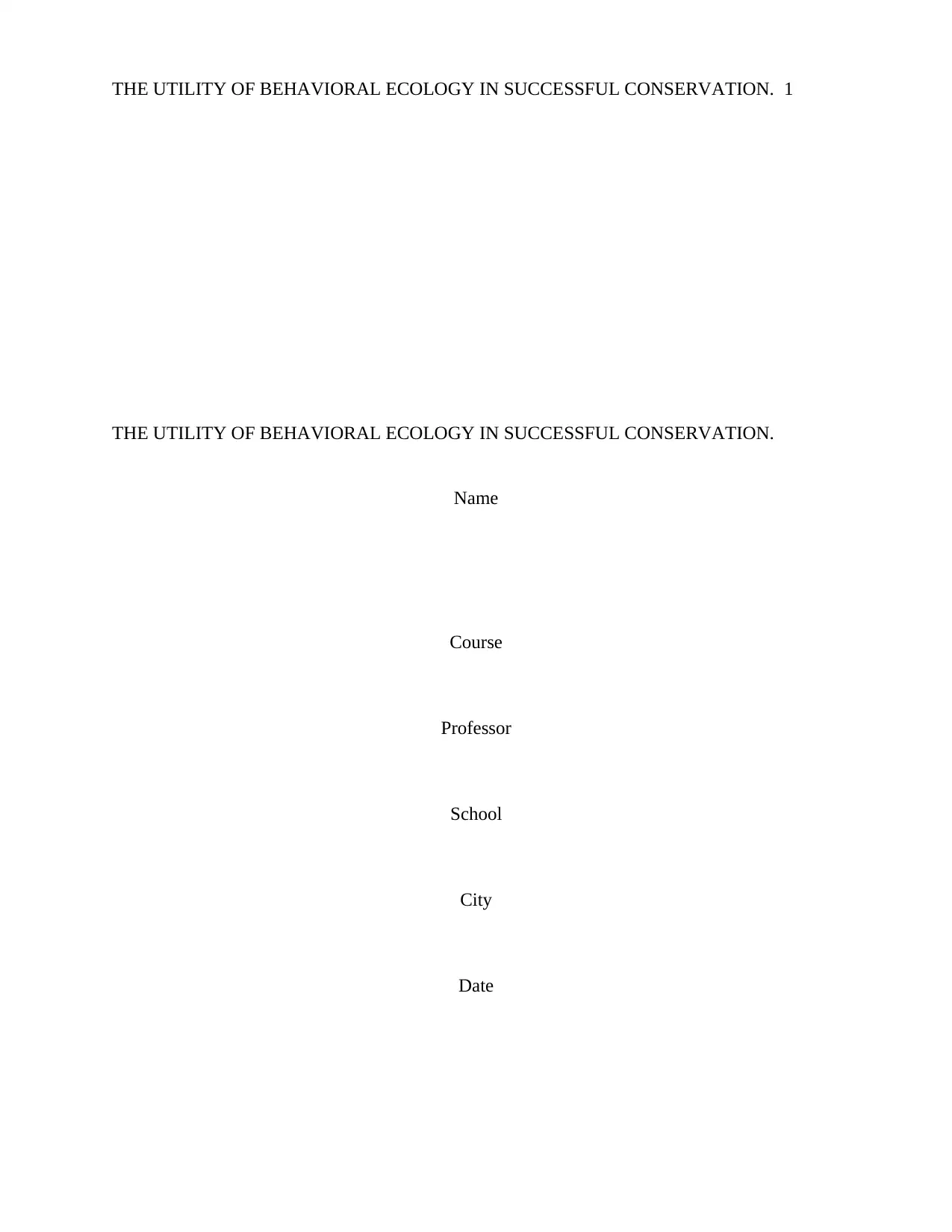
THE UTILITY OF BEHAVIORAL ECOLOGY IN SUCCESSFUL CONSERVATION. 1
THE UTILITY OF BEHAVIORAL ECOLOGY IN SUCCESSFUL CONSERVATION.
Name
Course
Professor
School
City
Date
THE UTILITY OF BEHAVIORAL ECOLOGY IN SUCCESSFUL CONSERVATION.
Name
Course
Professor
School
City
Date
Paraphrase This Document
Need a fresh take? Get an instant paraphrase of this document with our AI Paraphraser
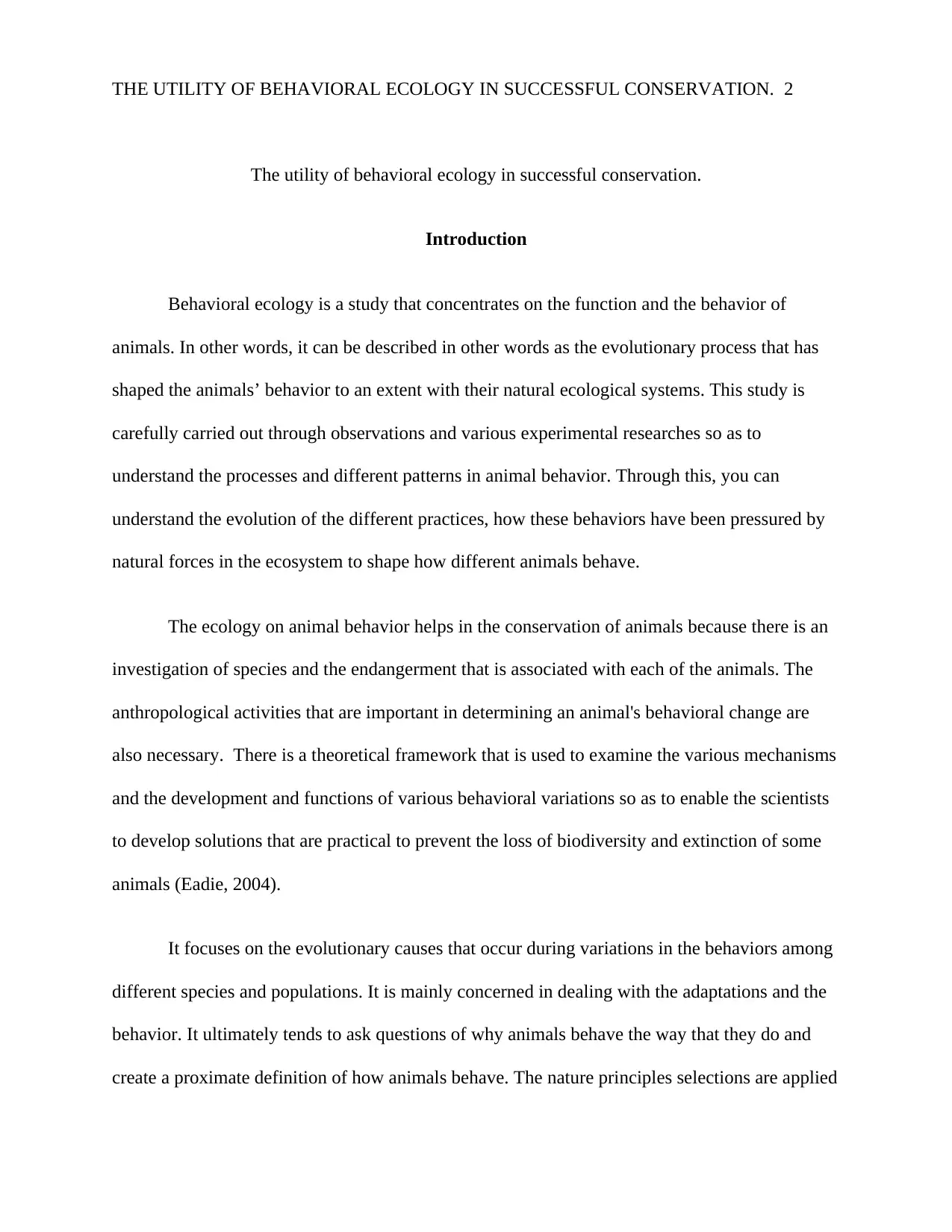
THE UTILITY OF BEHAVIORAL ECOLOGY IN SUCCESSFUL CONSERVATION. 2
The utility of behavioral ecology in successful conservation.
Introduction
Behavioral ecology is a study that concentrates on the function and the behavior of
animals. In other words, it can be described in other words as the evolutionary process that has
shaped the animals’ behavior to an extent with their natural ecological systems. This study is
carefully carried out through observations and various experimental researches so as to
understand the processes and different patterns in animal behavior. Through this, you can
understand the evolution of the different practices, how these behaviors have been pressured by
natural forces in the ecosystem to shape how different animals behave.
The ecology on animal behavior helps in the conservation of animals because there is an
investigation of species and the endangerment that is associated with each of the animals. The
anthropological activities that are important in determining an animal's behavioral change are
also necessary. There is a theoretical framework that is used to examine the various mechanisms
and the development and functions of various behavioral variations so as to enable the scientists
to develop solutions that are practical to prevent the loss of biodiversity and extinction of some
animals (Eadie, 2004).
It focuses on the evolutionary causes that occur during variations in the behaviors among
different species and populations. It is mainly concerned in dealing with the adaptations and the
behavior. It ultimately tends to ask questions of why animals behave the way that they do and
create a proximate definition of how animals behave. The nature principles selections are applied
The utility of behavioral ecology in successful conservation.
Introduction
Behavioral ecology is a study that concentrates on the function and the behavior of
animals. In other words, it can be described in other words as the evolutionary process that has
shaped the animals’ behavior to an extent with their natural ecological systems. This study is
carefully carried out through observations and various experimental researches so as to
understand the processes and different patterns in animal behavior. Through this, you can
understand the evolution of the different practices, how these behaviors have been pressured by
natural forces in the ecosystem to shape how different animals behave.
The ecology on animal behavior helps in the conservation of animals because there is an
investigation of species and the endangerment that is associated with each of the animals. The
anthropological activities that are important in determining an animal's behavioral change are
also necessary. There is a theoretical framework that is used to examine the various mechanisms
and the development and functions of various behavioral variations so as to enable the scientists
to develop solutions that are practical to prevent the loss of biodiversity and extinction of some
animals (Eadie, 2004).
It focuses on the evolutionary causes that occur during variations in the behaviors among
different species and populations. It is mainly concerned in dealing with the adaptations and the
behavior. It ultimately tends to ask questions of why animals behave the way that they do and
create a proximate definition of how animals behave. The nature principles selections are applied
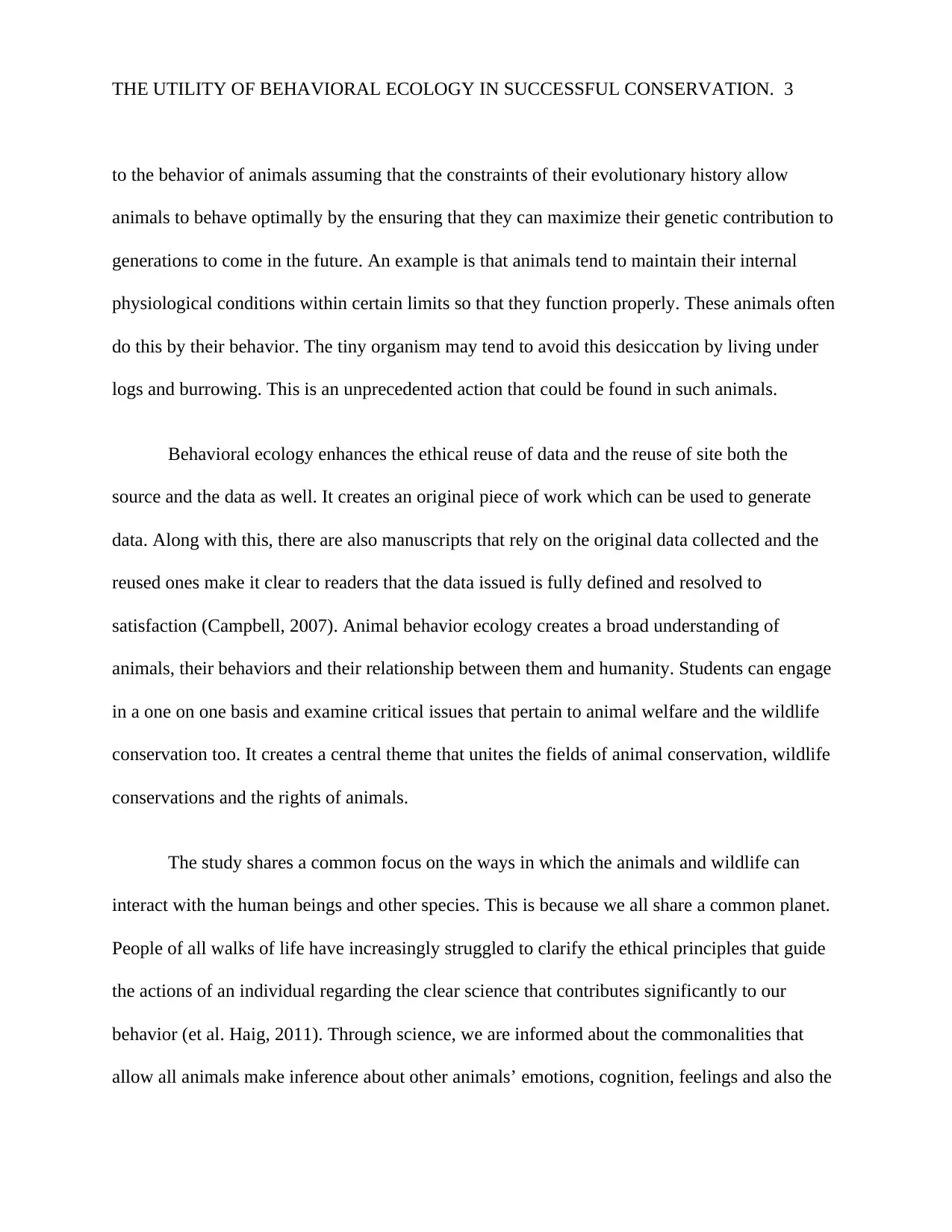
THE UTILITY OF BEHAVIORAL ECOLOGY IN SUCCESSFUL CONSERVATION. 3
to the behavior of animals assuming that the constraints of their evolutionary history allow
animals to behave optimally by the ensuring that they can maximize their genetic contribution to
generations to come in the future. An example is that animals tend to maintain their internal
physiological conditions within certain limits so that they function properly. These animals often
do this by their behavior. The tiny organism may tend to avoid this desiccation by living under
logs and burrowing. This is an unprecedented action that could be found in such animals.
Behavioral ecology enhances the ethical reuse of data and the reuse of site both the
source and the data as well. It creates an original piece of work which can be used to generate
data. Along with this, there are also manuscripts that rely on the original data collected and the
reused ones make it clear to readers that the data issued is fully defined and resolved to
satisfaction (Campbell, 2007). Animal behavior ecology creates a broad understanding of
animals, their behaviors and their relationship between them and humanity. Students can engage
in a one on one basis and examine critical issues that pertain to animal welfare and the wildlife
conservation too. It creates a central theme that unites the fields of animal conservation, wildlife
conservations and the rights of animals.
The study shares a common focus on the ways in which the animals and wildlife can
interact with the human beings and other species. This is because we all share a common planet.
People of all walks of life have increasingly struggled to clarify the ethical principles that guide
the actions of an individual regarding the clear science that contributes significantly to our
behavior (et al. Haig, 2011). Through science, we are informed about the commonalities that
allow all animals make inference about other animals’ emotions, cognition, feelings and also the
to the behavior of animals assuming that the constraints of their evolutionary history allow
animals to behave optimally by the ensuring that they can maximize their genetic contribution to
generations to come in the future. An example is that animals tend to maintain their internal
physiological conditions within certain limits so that they function properly. These animals often
do this by their behavior. The tiny organism may tend to avoid this desiccation by living under
logs and burrowing. This is an unprecedented action that could be found in such animals.
Behavioral ecology enhances the ethical reuse of data and the reuse of site both the
source and the data as well. It creates an original piece of work which can be used to generate
data. Along with this, there are also manuscripts that rely on the original data collected and the
reused ones make it clear to readers that the data issued is fully defined and resolved to
satisfaction (Campbell, 2007). Animal behavior ecology creates a broad understanding of
animals, their behaviors and their relationship between them and humanity. Students can engage
in a one on one basis and examine critical issues that pertain to animal welfare and the wildlife
conservation too. It creates a central theme that unites the fields of animal conservation, wildlife
conservations and the rights of animals.
The study shares a common focus on the ways in which the animals and wildlife can
interact with the human beings and other species. This is because we all share a common planet.
People of all walks of life have increasingly struggled to clarify the ethical principles that guide
the actions of an individual regarding the clear science that contributes significantly to our
behavior (et al. Haig, 2011). Through science, we are informed about the commonalities that
allow all animals make inference about other animals’ emotions, cognition, feelings and also the
⊘ This is a preview!⊘
Do you want full access?
Subscribe today to unlock all pages.

Trusted by 1+ million students worldwide
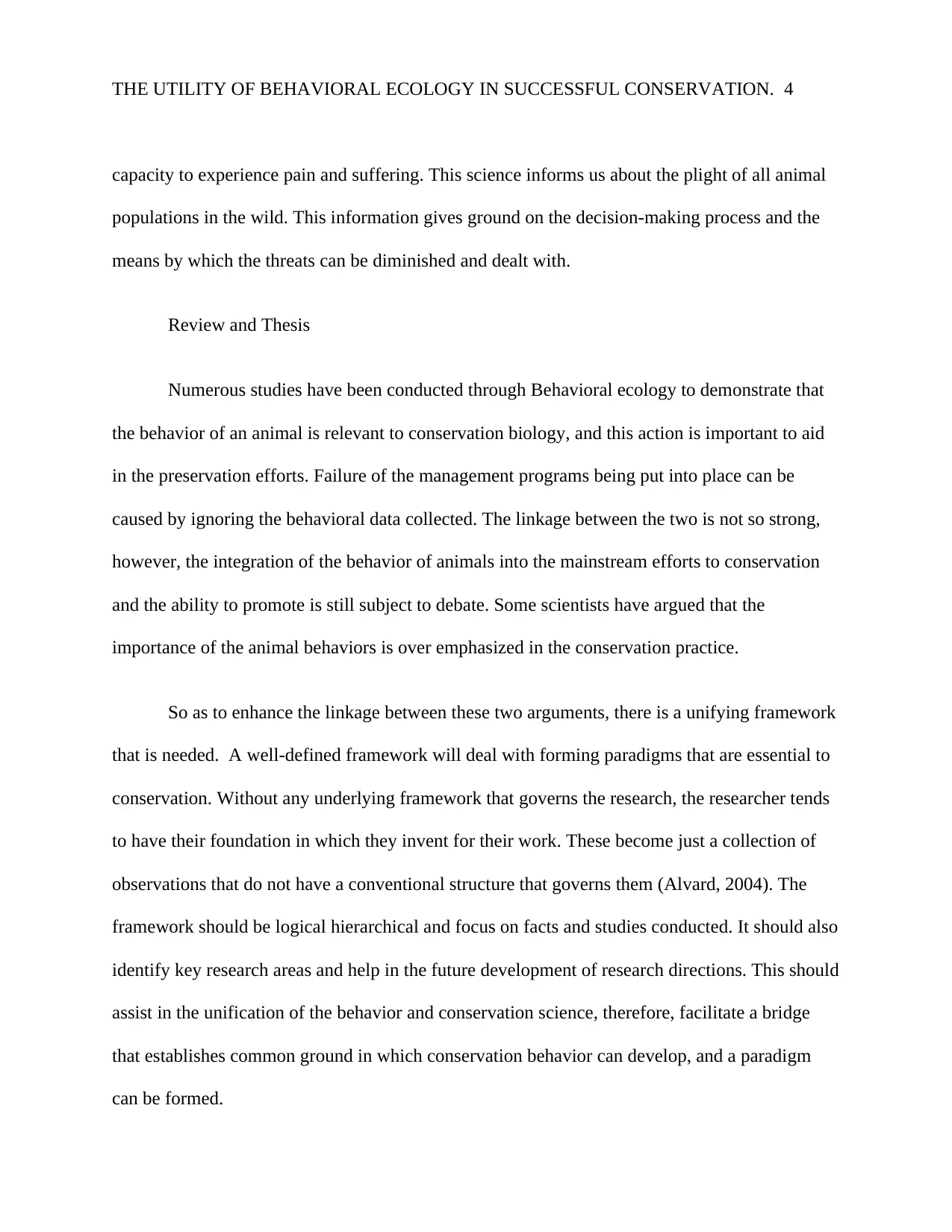
THE UTILITY OF BEHAVIORAL ECOLOGY IN SUCCESSFUL CONSERVATION. 4
capacity to experience pain and suffering. This science informs us about the plight of all animal
populations in the wild. This information gives ground on the decision-making process and the
means by which the threats can be diminished and dealt with.
Review and Thesis
Numerous studies have been conducted through Behavioral ecology to demonstrate that
the behavior of an animal is relevant to conservation biology, and this action is important to aid
in the preservation efforts. Failure of the management programs being put into place can be
caused by ignoring the behavioral data collected. The linkage between the two is not so strong,
however, the integration of the behavior of animals into the mainstream efforts to conservation
and the ability to promote is still subject to debate. Some scientists have argued that the
importance of the animal behaviors is over emphasized in the conservation practice.
So as to enhance the linkage between these two arguments, there is a unifying framework
that is needed. A well-defined framework will deal with forming paradigms that are essential to
conservation. Without any underlying framework that governs the research, the researcher tends
to have their foundation in which they invent for their work. These become just a collection of
observations that do not have a conventional structure that governs them (Alvard, 2004). The
framework should be logical hierarchical and focus on facts and studies conducted. It should also
identify key research areas and help in the future development of research directions. This should
assist in the unification of the behavior and conservation science, therefore, facilitate a bridge
that establishes common ground in which conservation behavior can develop, and a paradigm
can be formed.
capacity to experience pain and suffering. This science informs us about the plight of all animal
populations in the wild. This information gives ground on the decision-making process and the
means by which the threats can be diminished and dealt with.
Review and Thesis
Numerous studies have been conducted through Behavioral ecology to demonstrate that
the behavior of an animal is relevant to conservation biology, and this action is important to aid
in the preservation efforts. Failure of the management programs being put into place can be
caused by ignoring the behavioral data collected. The linkage between the two is not so strong,
however, the integration of the behavior of animals into the mainstream efforts to conservation
and the ability to promote is still subject to debate. Some scientists have argued that the
importance of the animal behaviors is over emphasized in the conservation practice.
So as to enhance the linkage between these two arguments, there is a unifying framework
that is needed. A well-defined framework will deal with forming paradigms that are essential to
conservation. Without any underlying framework that governs the research, the researcher tends
to have their foundation in which they invent for their work. These become just a collection of
observations that do not have a conventional structure that governs them (Alvard, 2004). The
framework should be logical hierarchical and focus on facts and studies conducted. It should also
identify key research areas and help in the future development of research directions. This should
assist in the unification of the behavior and conservation science, therefore, facilitate a bridge
that establishes common ground in which conservation behavior can develop, and a paradigm
can be formed.
Paraphrase This Document
Need a fresh take? Get an instant paraphrase of this document with our AI Paraphraser
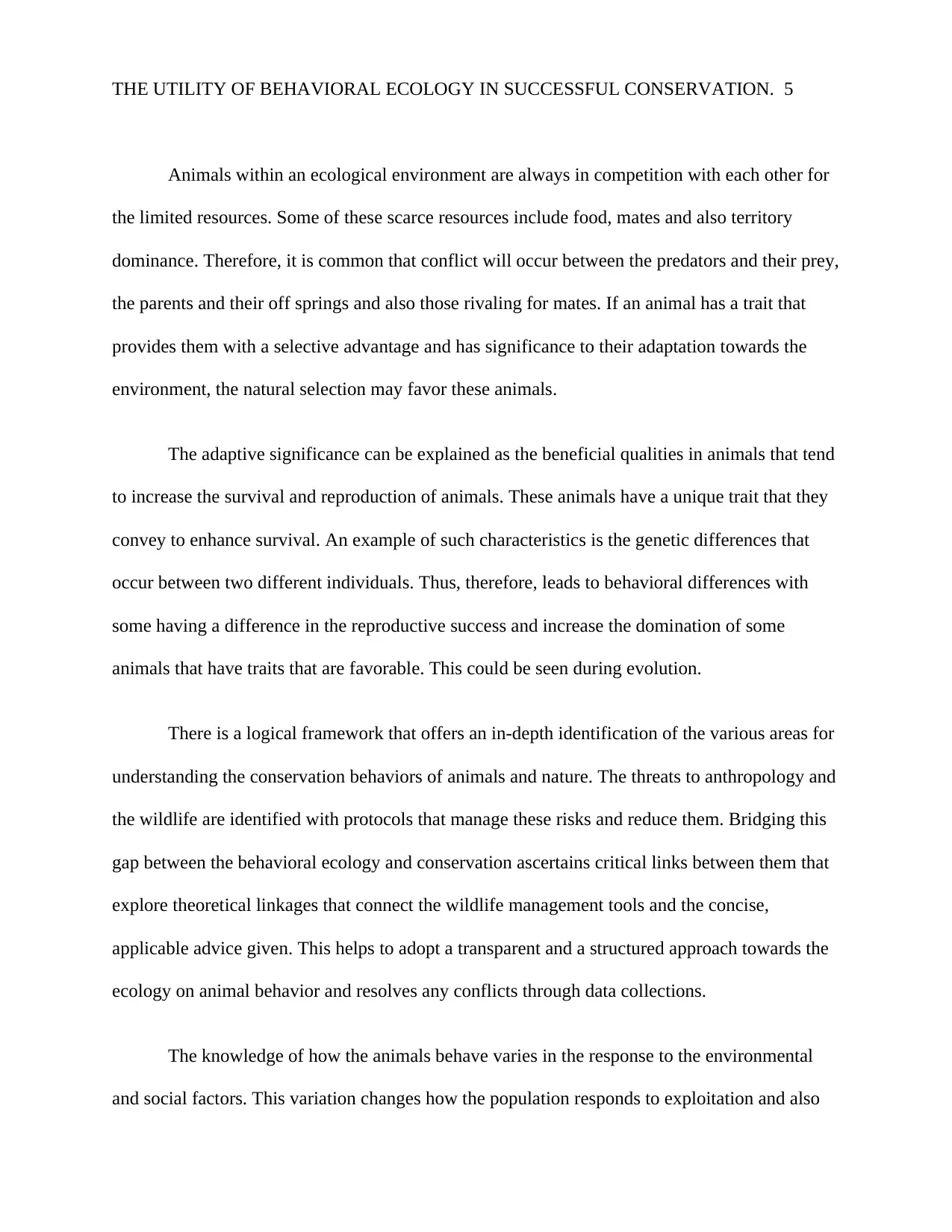
THE UTILITY OF BEHAVIORAL ECOLOGY IN SUCCESSFUL CONSERVATION. 5
Animals within an ecological environment are always in competition with each other for
the limited resources. Some of these scarce resources include food, mates and also territory
dominance. Therefore, it is common that conflict will occur between the predators and their prey,
the parents and their off springs and also those rivaling for mates. If an animal has a trait that
provides them with a selective advantage and has significance to their adaptation towards the
environment, the natural selection may favor these animals.
The adaptive significance can be explained as the beneficial qualities in animals that tend
to increase the survival and reproduction of animals. These animals have a unique trait that they
convey to enhance survival. An example of such characteristics is the genetic differences that
occur between two different individuals. Thus, therefore, leads to behavioral differences with
some having a difference in the reproductive success and increase the domination of some
animals that have traits that are favorable. This could be seen during evolution.
There is a logical framework that offers an in-depth identification of the various areas for
understanding the conservation behaviors of animals and nature. The threats to anthropology and
the wildlife are identified with protocols that manage these risks and reduce them. Bridging this
gap between the behavioral ecology and conservation ascertains critical links between them that
explore theoretical linkages that connect the wildlife management tools and the concise,
applicable advice given. This helps to adopt a transparent and a structured approach towards the
ecology on animal behavior and resolves any conflicts through data collections.
The knowledge of how the animals behave varies in the response to the environmental
and social factors. This variation changes how the population responds to exploitation and also
Animals within an ecological environment are always in competition with each other for
the limited resources. Some of these scarce resources include food, mates and also territory
dominance. Therefore, it is common that conflict will occur between the predators and their prey,
the parents and their off springs and also those rivaling for mates. If an animal has a trait that
provides them with a selective advantage and has significance to their adaptation towards the
environment, the natural selection may favor these animals.
The adaptive significance can be explained as the beneficial qualities in animals that tend
to increase the survival and reproduction of animals. These animals have a unique trait that they
convey to enhance survival. An example of such characteristics is the genetic differences that
occur between two different individuals. Thus, therefore, leads to behavioral differences with
some having a difference in the reproductive success and increase the domination of some
animals that have traits that are favorable. This could be seen during evolution.
There is a logical framework that offers an in-depth identification of the various areas for
understanding the conservation behaviors of animals and nature. The threats to anthropology and
the wildlife are identified with protocols that manage these risks and reduce them. Bridging this
gap between the behavioral ecology and conservation ascertains critical links between them that
explore theoretical linkages that connect the wildlife management tools and the concise,
applicable advice given. This helps to adopt a transparent and a structured approach towards the
ecology on animal behavior and resolves any conflicts through data collections.
The knowledge of how the animals behave varies in the response to the environmental
and social factors. This variation changes how the population responds to exploitation and also
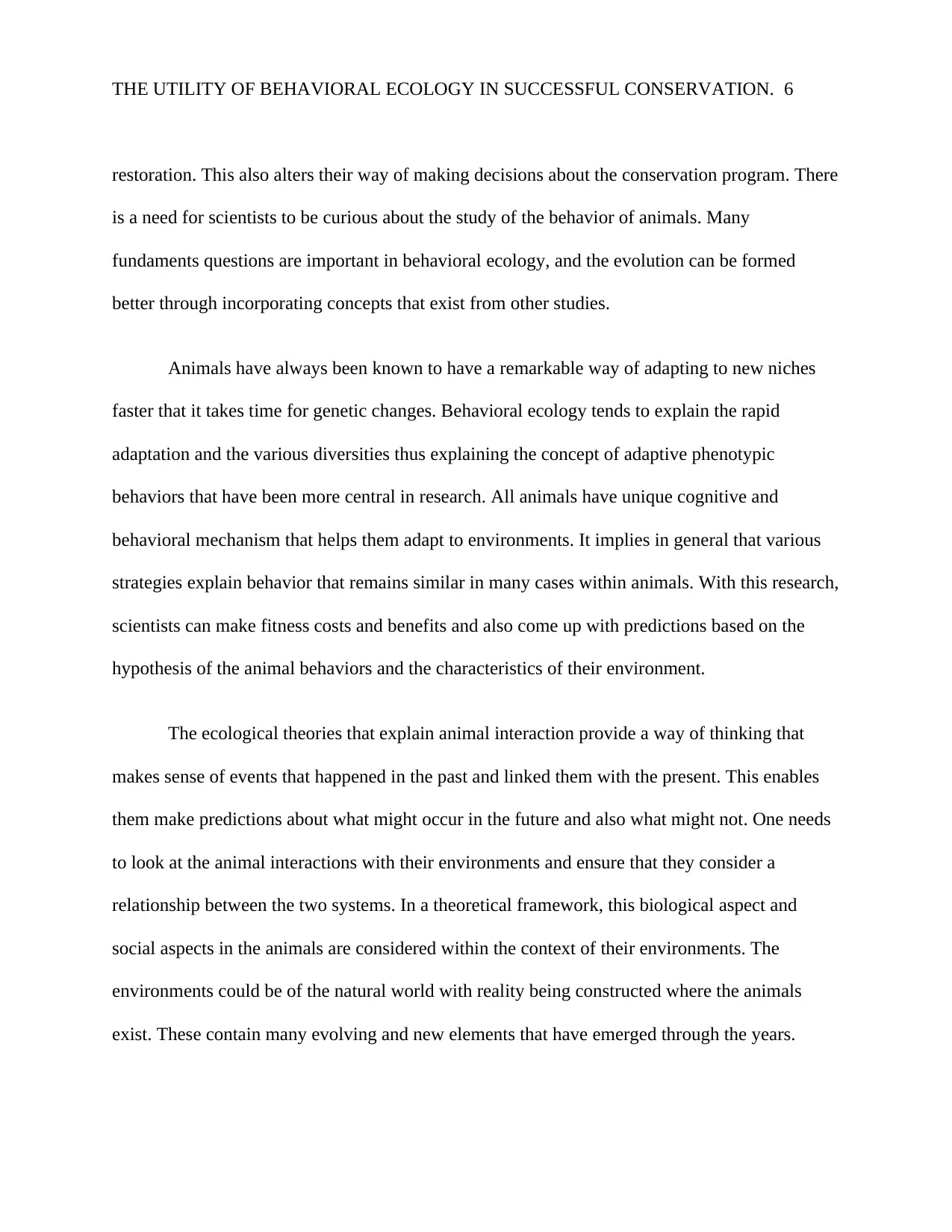
THE UTILITY OF BEHAVIORAL ECOLOGY IN SUCCESSFUL CONSERVATION. 6
restoration. This also alters their way of making decisions about the conservation program. There
is a need for scientists to be curious about the study of the behavior of animals. Many
fundaments questions are important in behavioral ecology, and the evolution can be formed
better through incorporating concepts that exist from other studies.
Animals have always been known to have a remarkable way of adapting to new niches
faster that it takes time for genetic changes. Behavioral ecology tends to explain the rapid
adaptation and the various diversities thus explaining the concept of adaptive phenotypic
behaviors that have been more central in research. All animals have unique cognitive and
behavioral mechanism that helps them adapt to environments. It implies in general that various
strategies explain behavior that remains similar in many cases within animals. With this research,
scientists can make fitness costs and benefits and also come up with predictions based on the
hypothesis of the animal behaviors and the characteristics of their environment.
The ecological theories that explain animal interaction provide a way of thinking that
makes sense of events that happened in the past and linked them with the present. This enables
them make predictions about what might occur in the future and also what might not. One needs
to look at the animal interactions with their environments and ensure that they consider a
relationship between the two systems. In a theoretical framework, this biological aspect and
social aspects in the animals are considered within the context of their environments. The
environments could be of the natural world with reality being constructed where the animals
exist. These contain many evolving and new elements that have emerged through the years.
restoration. This also alters their way of making decisions about the conservation program. There
is a need for scientists to be curious about the study of the behavior of animals. Many
fundaments questions are important in behavioral ecology, and the evolution can be formed
better through incorporating concepts that exist from other studies.
Animals have always been known to have a remarkable way of adapting to new niches
faster that it takes time for genetic changes. Behavioral ecology tends to explain the rapid
adaptation and the various diversities thus explaining the concept of adaptive phenotypic
behaviors that have been more central in research. All animals have unique cognitive and
behavioral mechanism that helps them adapt to environments. It implies in general that various
strategies explain behavior that remains similar in many cases within animals. With this research,
scientists can make fitness costs and benefits and also come up with predictions based on the
hypothesis of the animal behaviors and the characteristics of their environment.
The ecological theories that explain animal interaction provide a way of thinking that
makes sense of events that happened in the past and linked them with the present. This enables
them make predictions about what might occur in the future and also what might not. One needs
to look at the animal interactions with their environments and ensure that they consider a
relationship between the two systems. In a theoretical framework, this biological aspect and
social aspects in the animals are considered within the context of their environments. The
environments could be of the natural world with reality being constructed where the animals
exist. These contain many evolving and new elements that have emerged through the years.
⊘ This is a preview!⊘
Do you want full access?
Subscribe today to unlock all pages.

Trusted by 1+ million students worldwide
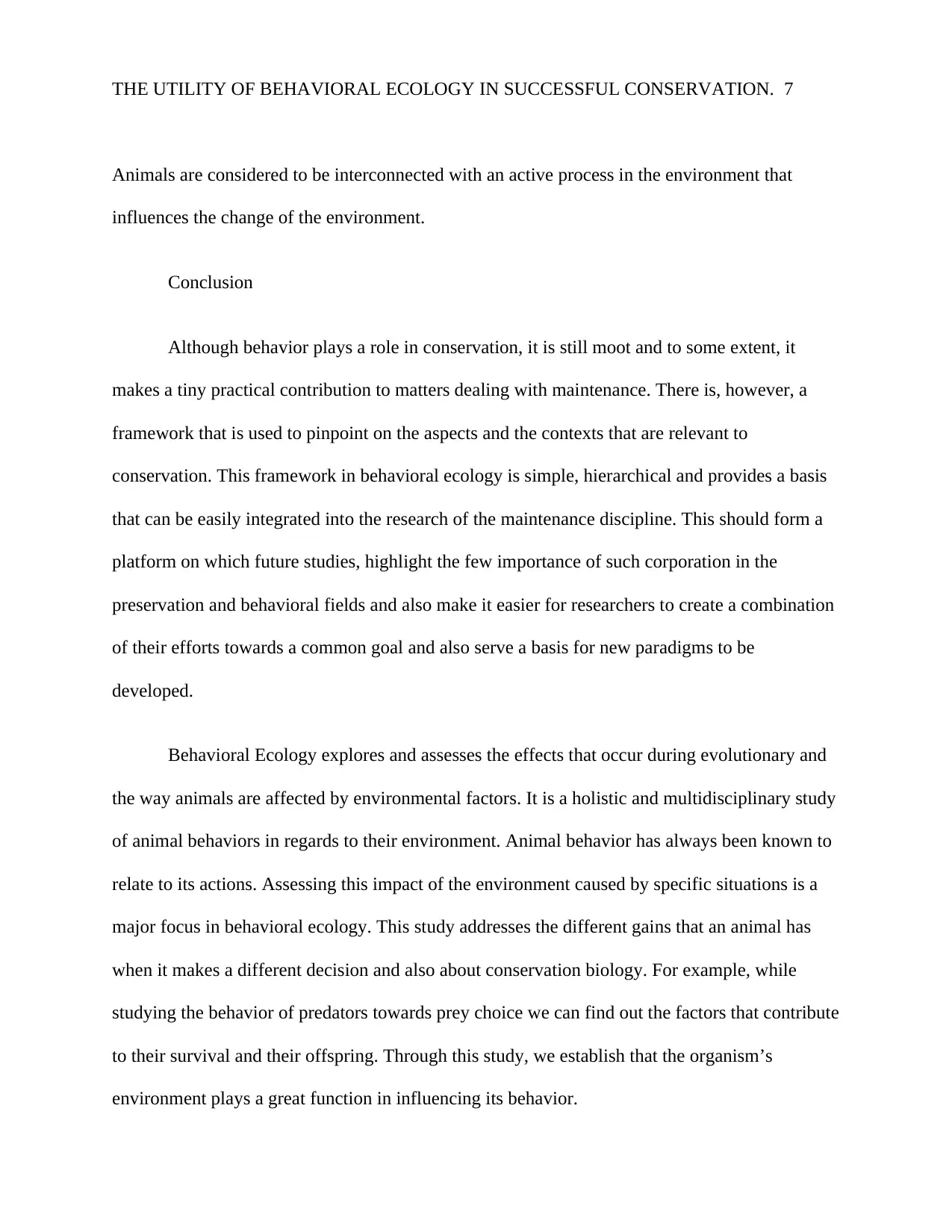
THE UTILITY OF BEHAVIORAL ECOLOGY IN SUCCESSFUL CONSERVATION. 7
Animals are considered to be interconnected with an active process in the environment that
influences the change of the environment.
Conclusion
Although behavior plays a role in conservation, it is still moot and to some extent, it
makes a tiny practical contribution to matters dealing with maintenance. There is, however, a
framework that is used to pinpoint on the aspects and the contexts that are relevant to
conservation. This framework in behavioral ecology is simple, hierarchical and provides a basis
that can be easily integrated into the research of the maintenance discipline. This should form a
platform on which future studies, highlight the few importance of such corporation in the
preservation and behavioral fields and also make it easier for researchers to create a combination
of their efforts towards a common goal and also serve a basis for new paradigms to be
developed.
Behavioral Ecology explores and assesses the effects that occur during evolutionary and
the way animals are affected by environmental factors. It is a holistic and multidisciplinary study
of animal behaviors in regards to their environment. Animal behavior has always been known to
relate to its actions. Assessing this impact of the environment caused by specific situations is a
major focus in behavioral ecology. This study addresses the different gains that an animal has
when it makes a different decision and also about conservation biology. For example, while
studying the behavior of predators towards prey choice we can find out the factors that contribute
to their survival and their offspring. Through this study, we establish that the organism’s
environment plays a great function in influencing its behavior.
Animals are considered to be interconnected with an active process in the environment that
influences the change of the environment.
Conclusion
Although behavior plays a role in conservation, it is still moot and to some extent, it
makes a tiny practical contribution to matters dealing with maintenance. There is, however, a
framework that is used to pinpoint on the aspects and the contexts that are relevant to
conservation. This framework in behavioral ecology is simple, hierarchical and provides a basis
that can be easily integrated into the research of the maintenance discipline. This should form a
platform on which future studies, highlight the few importance of such corporation in the
preservation and behavioral fields and also make it easier for researchers to create a combination
of their efforts towards a common goal and also serve a basis for new paradigms to be
developed.
Behavioral Ecology explores and assesses the effects that occur during evolutionary and
the way animals are affected by environmental factors. It is a holistic and multidisciplinary study
of animal behaviors in regards to their environment. Animal behavior has always been known to
relate to its actions. Assessing this impact of the environment caused by specific situations is a
major focus in behavioral ecology. This study addresses the different gains that an animal has
when it makes a different decision and also about conservation biology. For example, while
studying the behavior of predators towards prey choice we can find out the factors that contribute
to their survival and their offspring. Through this study, we establish that the organism’s
environment plays a great function in influencing its behavior.
Paraphrase This Document
Need a fresh take? Get an instant paraphrase of this document with our AI Paraphraser
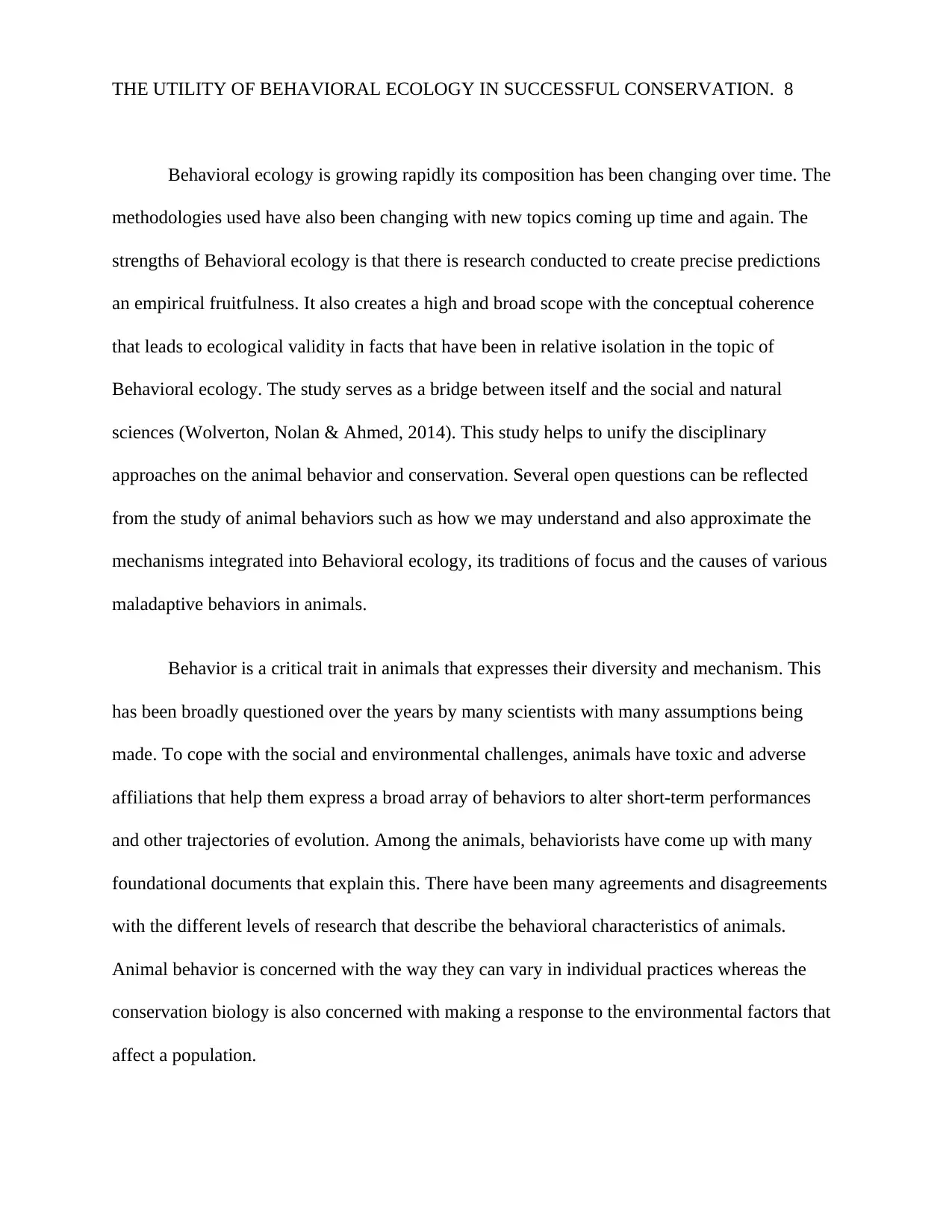
THE UTILITY OF BEHAVIORAL ECOLOGY IN SUCCESSFUL CONSERVATION. 8
Behavioral ecology is growing rapidly its composition has been changing over time. The
methodologies used have also been changing with new topics coming up time and again. The
strengths of Behavioral ecology is that there is research conducted to create precise predictions
an empirical fruitfulness. It also creates a high and broad scope with the conceptual coherence
that leads to ecological validity in facts that have been in relative isolation in the topic of
Behavioral ecology. The study serves as a bridge between itself and the social and natural
sciences (Wolverton, Nolan & Ahmed, 2014). This study helps to unify the disciplinary
approaches on the animal behavior and conservation. Several open questions can be reflected
from the study of animal behaviors such as how we may understand and also approximate the
mechanisms integrated into Behavioral ecology, its traditions of focus and the causes of various
maladaptive behaviors in animals.
Behavior is a critical trait in animals that expresses their diversity and mechanism. This
has been broadly questioned over the years by many scientists with many assumptions being
made. To cope with the social and environmental challenges, animals have toxic and adverse
affiliations that help them express a broad array of behaviors to alter short-term performances
and other trajectories of evolution. Among the animals, behaviorists have come up with many
foundational documents that explain this. There have been many agreements and disagreements
with the different levels of research that describe the behavioral characteristics of animals.
Animal behavior is concerned with the way they can vary in individual practices whereas the
conservation biology is also concerned with making a response to the environmental factors that
affect a population.
Behavioral ecology is growing rapidly its composition has been changing over time. The
methodologies used have also been changing with new topics coming up time and again. The
strengths of Behavioral ecology is that there is research conducted to create precise predictions
an empirical fruitfulness. It also creates a high and broad scope with the conceptual coherence
that leads to ecological validity in facts that have been in relative isolation in the topic of
Behavioral ecology. The study serves as a bridge between itself and the social and natural
sciences (Wolverton, Nolan & Ahmed, 2014). This study helps to unify the disciplinary
approaches on the animal behavior and conservation. Several open questions can be reflected
from the study of animal behaviors such as how we may understand and also approximate the
mechanisms integrated into Behavioral ecology, its traditions of focus and the causes of various
maladaptive behaviors in animals.
Behavior is a critical trait in animals that expresses their diversity and mechanism. This
has been broadly questioned over the years by many scientists with many assumptions being
made. To cope with the social and environmental challenges, animals have toxic and adverse
affiliations that help them express a broad array of behaviors to alter short-term performances
and other trajectories of evolution. Among the animals, behaviorists have come up with many
foundational documents that explain this. There have been many agreements and disagreements
with the different levels of research that describe the behavioral characteristics of animals.
Animal behavior is concerned with the way they can vary in individual practices whereas the
conservation biology is also concerned with making a response to the environmental factors that
affect a population.
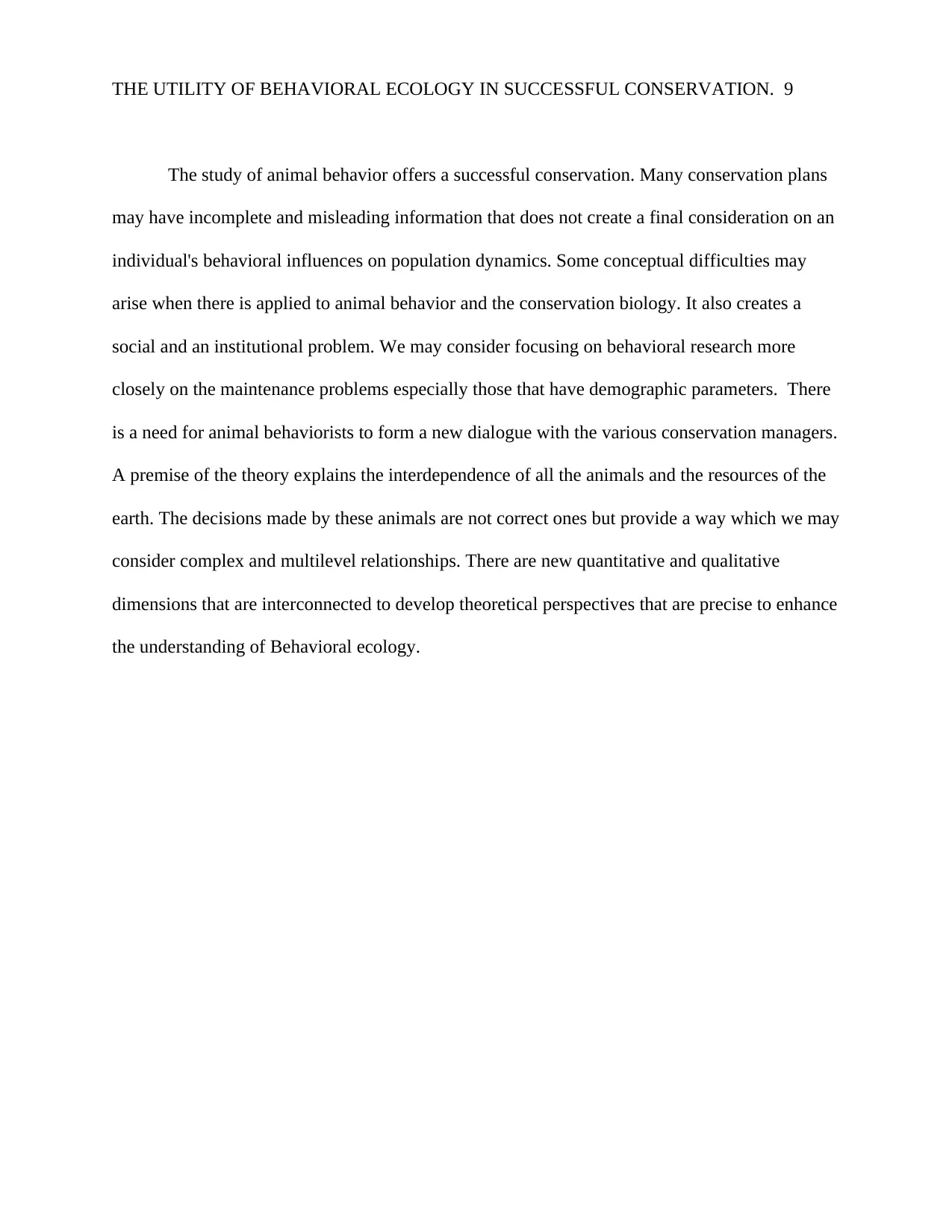
THE UTILITY OF BEHAVIORAL ECOLOGY IN SUCCESSFUL CONSERVATION. 9
The study of animal behavior offers a successful conservation. Many conservation plans
may have incomplete and misleading information that does not create a final consideration on an
individual's behavioral influences on population dynamics. Some conceptual difficulties may
arise when there is applied to animal behavior and the conservation biology. It also creates a
social and an institutional problem. We may consider focusing on behavioral research more
closely on the maintenance problems especially those that have demographic parameters. There
is a need for animal behaviorists to form a new dialogue with the various conservation managers.
A premise of the theory explains the interdependence of all the animals and the resources of the
earth. The decisions made by these animals are not correct ones but provide a way which we may
consider complex and multilevel relationships. There are new quantitative and qualitative
dimensions that are interconnected to develop theoretical perspectives that are precise to enhance
the understanding of Behavioral ecology.
The study of animal behavior offers a successful conservation. Many conservation plans
may have incomplete and misleading information that does not create a final consideration on an
individual's behavioral influences on population dynamics. Some conceptual difficulties may
arise when there is applied to animal behavior and the conservation biology. It also creates a
social and an institutional problem. We may consider focusing on behavioral research more
closely on the maintenance problems especially those that have demographic parameters. There
is a need for animal behaviorists to form a new dialogue with the various conservation managers.
A premise of the theory explains the interdependence of all the animals and the resources of the
earth. The decisions made by these animals are not correct ones but provide a way which we may
consider complex and multilevel relationships. There are new quantitative and qualitative
dimensions that are interconnected to develop theoretical perspectives that are precise to enhance
the understanding of Behavioral ecology.
⊘ This is a preview!⊘
Do you want full access?
Subscribe today to unlock all pages.

Trusted by 1+ million students worldwide
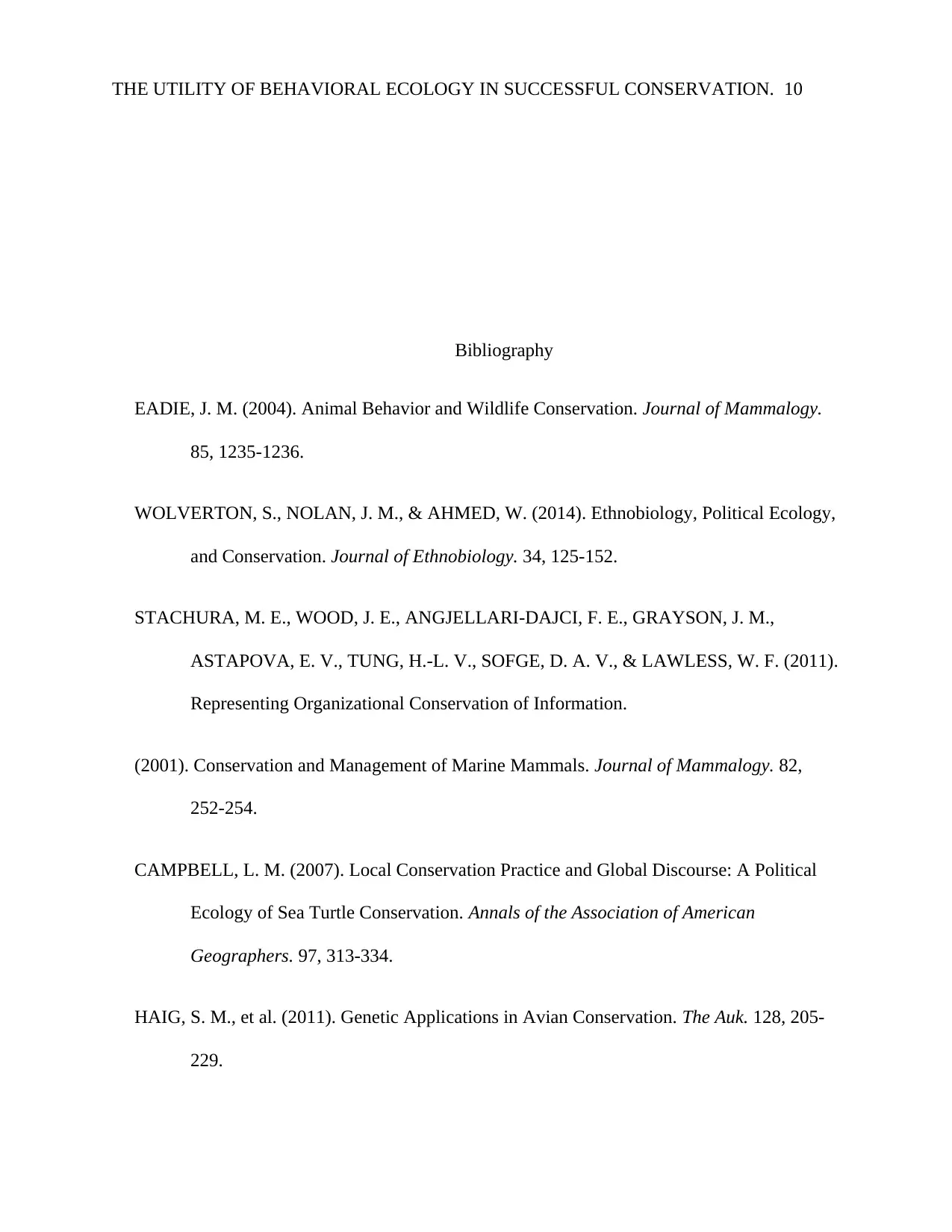
THE UTILITY OF BEHAVIORAL ECOLOGY IN SUCCESSFUL CONSERVATION. 10
Bibliography
EADIE, J. M. (2004). Animal Behavior and Wildlife Conservation. Journal of Mammalogy.
85, 1235-1236.
WOLVERTON, S., NOLAN, J. M., & AHMED, W. (2014). Ethnobiology, Political Ecology,
and Conservation. Journal of Ethnobiology. 34, 125-152.
STACHURA, M. E., WOOD, J. E., ANGJELLARI-DAJCI, F. E., GRAYSON, J. M.,
ASTAPOVA, E. V., TUNG, H.-L. V., SOFGE, D. A. V., & LAWLESS, W. F. (2011).
Representing Organizational Conservation of Information.
(2001). Conservation and Management of Marine Mammals. Journal of Mammalogy. 82,
252-254.
CAMPBELL, L. M. (2007). Local Conservation Practice and Global Discourse: A Political
Ecology of Sea Turtle Conservation. Annals of the Association of American
Geographers. 97, 313-334.
HAIG, S. M., et al. (2011). Genetic Applications in Avian Conservation. The Auk. 128, 205-
229.
Bibliography
EADIE, J. M. (2004). Animal Behavior and Wildlife Conservation. Journal of Mammalogy.
85, 1235-1236.
WOLVERTON, S., NOLAN, J. M., & AHMED, W. (2014). Ethnobiology, Political Ecology,
and Conservation. Journal of Ethnobiology. 34, 125-152.
STACHURA, M. E., WOOD, J. E., ANGJELLARI-DAJCI, F. E., GRAYSON, J. M.,
ASTAPOVA, E. V., TUNG, H.-L. V., SOFGE, D. A. V., & LAWLESS, W. F. (2011).
Representing Organizational Conservation of Information.
(2001). Conservation and Management of Marine Mammals. Journal of Mammalogy. 82,
252-254.
CAMPBELL, L. M. (2007). Local Conservation Practice and Global Discourse: A Political
Ecology of Sea Turtle Conservation. Annals of the Association of American
Geographers. 97, 313-334.
HAIG, S. M., et al. (2011). Genetic Applications in Avian Conservation. The Auk. 128, 205-
229.
Paraphrase This Document
Need a fresh take? Get an instant paraphrase of this document with our AI Paraphraser
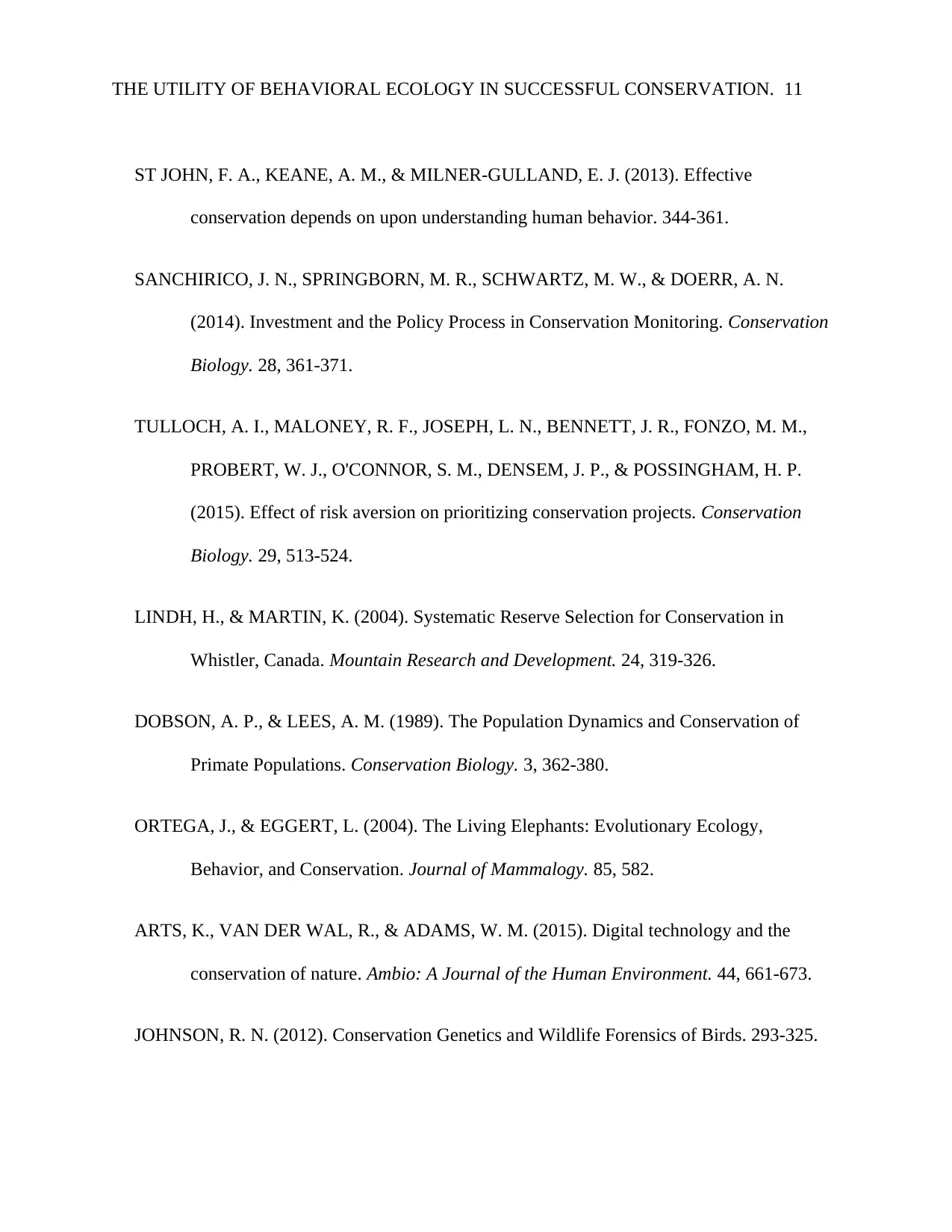
THE UTILITY OF BEHAVIORAL ECOLOGY IN SUCCESSFUL CONSERVATION. 11
ST JOHN, F. A., KEANE, A. M., & MILNER-GULLAND, E. J. (2013). Effective
conservation depends on upon understanding human behavior. 344-361.
SANCHIRICO, J. N., SPRINGBORN, M. R., SCHWARTZ, M. W., & DOERR, A. N.
(2014). Investment and the Policy Process in Conservation Monitoring. Conservation
Biology. 28, 361-371.
TULLOCH, A. I., MALONEY, R. F., JOSEPH, L. N., BENNETT, J. R., FONZO, M. M.,
PROBERT, W. J., O'CONNOR, S. M., DENSEM, J. P., & POSSINGHAM, H. P.
(2015). Effect of risk aversion on prioritizing conservation projects. Conservation
Biology. 29, 513-524.
LINDH, H., & MARTIN, K. (2004). Systematic Reserve Selection for Conservation in
Whistler, Canada. Mountain Research and Development. 24, 319-326.
DOBSON, A. P., & LEES, A. M. (1989). The Population Dynamics and Conservation of
Primate Populations. Conservation Biology. 3, 362-380.
ORTEGA, J., & EGGERT, L. (2004). The Living Elephants: Evolutionary Ecology,
Behavior, and Conservation. Journal of Mammalogy. 85, 582.
ARTS, K., VAN DER WAL, R., & ADAMS, W. M. (2015). Digital technology and the
conservation of nature. Ambio: A Journal of the Human Environment. 44, 661-673.
JOHNSON, R. N. (2012). Conservation Genetics and Wildlife Forensics of Birds. 293-325.
ST JOHN, F. A., KEANE, A. M., & MILNER-GULLAND, E. J. (2013). Effective
conservation depends on upon understanding human behavior. 344-361.
SANCHIRICO, J. N., SPRINGBORN, M. R., SCHWARTZ, M. W., & DOERR, A. N.
(2014). Investment and the Policy Process in Conservation Monitoring. Conservation
Biology. 28, 361-371.
TULLOCH, A. I., MALONEY, R. F., JOSEPH, L. N., BENNETT, J. R., FONZO, M. M.,
PROBERT, W. J., O'CONNOR, S. M., DENSEM, J. P., & POSSINGHAM, H. P.
(2015). Effect of risk aversion on prioritizing conservation projects. Conservation
Biology. 29, 513-524.
LINDH, H., & MARTIN, K. (2004). Systematic Reserve Selection for Conservation in
Whistler, Canada. Mountain Research and Development. 24, 319-326.
DOBSON, A. P., & LEES, A. M. (1989). The Population Dynamics and Conservation of
Primate Populations. Conservation Biology. 3, 362-380.
ORTEGA, J., & EGGERT, L. (2004). The Living Elephants: Evolutionary Ecology,
Behavior, and Conservation. Journal of Mammalogy. 85, 582.
ARTS, K., VAN DER WAL, R., & ADAMS, W. M. (2015). Digital technology and the
conservation of nature. Ambio: A Journal of the Human Environment. 44, 661-673.
JOHNSON, R. N. (2012). Conservation Genetics and Wildlife Forensics of Birds. 293-325.
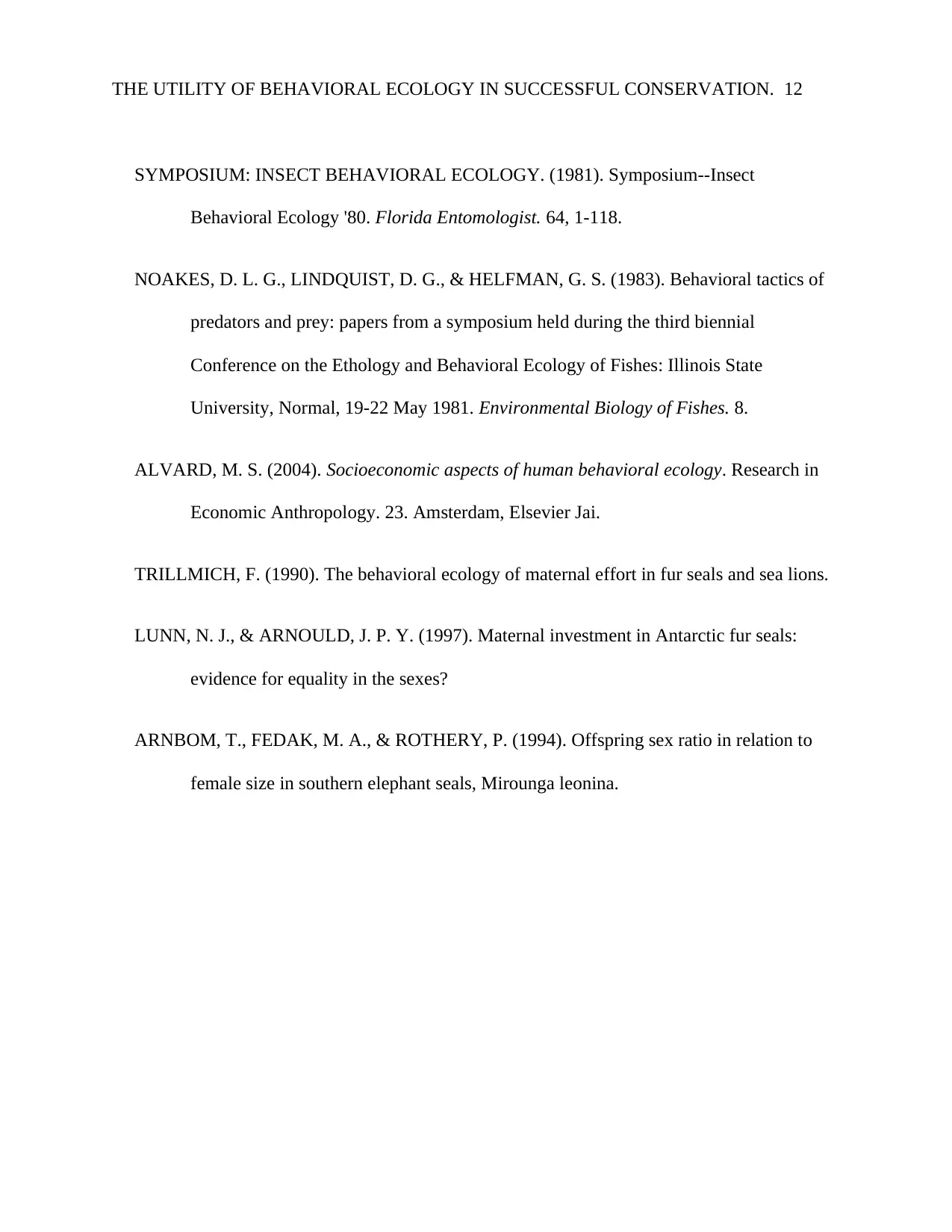
THE UTILITY OF BEHAVIORAL ECOLOGY IN SUCCESSFUL CONSERVATION. 12
SYMPOSIUM: INSECT BEHAVIORAL ECOLOGY. (1981). Symposium--Insect
Behavioral Ecology '80. Florida Entomologist. 64, 1-118.
NOAKES, D. L. G., LINDQUIST, D. G., & HELFMAN, G. S. (1983). Behavioral tactics of
predators and prey: papers from a symposium held during the third biennial
Conference on the Ethology and Behavioral Ecology of Fishes: Illinois State
University, Normal, 19-22 May 1981. Environmental Biology of Fishes. 8.
ALVARD, M. S. (2004). Socioeconomic aspects of human behavioral ecology. Research in
Economic Anthropology. 23. Amsterdam, Elsevier Jai.
TRILLMICH, F. (1990). The behavioral ecology of maternal effort in fur seals and sea lions.
LUNN, N. J., & ARNOULD, J. P. Y. (1997). Maternal investment in Antarctic fur seals:
evidence for equality in the sexes?
ARNBOM, T., FEDAK, M. A., & ROTHERY, P. (1994). Offspring sex ratio in relation to
female size in southern elephant seals, Mirounga leonina.
SYMPOSIUM: INSECT BEHAVIORAL ECOLOGY. (1981). Symposium--Insect
Behavioral Ecology '80. Florida Entomologist. 64, 1-118.
NOAKES, D. L. G., LINDQUIST, D. G., & HELFMAN, G. S. (1983). Behavioral tactics of
predators and prey: papers from a symposium held during the third biennial
Conference on the Ethology and Behavioral Ecology of Fishes: Illinois State
University, Normal, 19-22 May 1981. Environmental Biology of Fishes. 8.
ALVARD, M. S. (2004). Socioeconomic aspects of human behavioral ecology. Research in
Economic Anthropology. 23. Amsterdam, Elsevier Jai.
TRILLMICH, F. (1990). The behavioral ecology of maternal effort in fur seals and sea lions.
LUNN, N. J., & ARNOULD, J. P. Y. (1997). Maternal investment in Antarctic fur seals:
evidence for equality in the sexes?
ARNBOM, T., FEDAK, M. A., & ROTHERY, P. (1994). Offspring sex ratio in relation to
female size in southern elephant seals, Mirounga leonina.
⊘ This is a preview!⊘
Do you want full access?
Subscribe today to unlock all pages.

Trusted by 1+ million students worldwide
1 out of 12
Related Documents
Your All-in-One AI-Powered Toolkit for Academic Success.
+13062052269
info@desklib.com
Available 24*7 on WhatsApp / Email
![[object Object]](/_next/static/media/star-bottom.7253800d.svg)
Unlock your academic potential
Copyright © 2020–2025 A2Z Services. All Rights Reserved. Developed and managed by ZUCOL.



